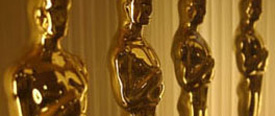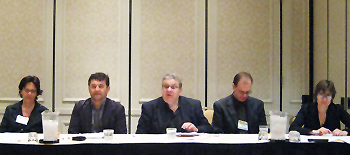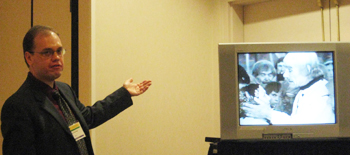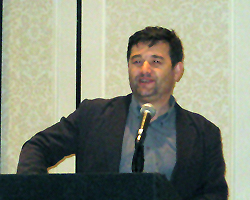 |
|||||||
Cinenews Archives

Ukrainian Film Studies Go Mainstream
November, 2007. New
Orleans, Louisiana.
In the program of the recent annual convention
of the American Association for the Advancement of Slavic Studies (AAASS)
that took place on November 16-18, 2007 in New Orleans, one could easily
overlook an important new development. For the first time in the history
of this forum, a special panel was organized to focus specifically
on Ukrainian film studies. The panel “Cinema and the Emergence
of Modern Ukrainian Identity,” sponsored by the Ukrainian Studies
Program and Ukrainian Film Club of Columbia University, featured a
discipline that in the American academic curriculum and agenda has
yet to attain the prominence and weight that is rightfully its own.
Unlike history, literature, language, political science, and sociology—in
North America, all well-established areas of Ukrainian studies, film
studies, undertaken sporadically by individual scholars, has yet to
emerge as a discipline comparable to that of film studies for other
Central and East European arenas, for example, Polish, Czech, Hungarian,
or Bulgarian.
 |
| Panel participants, from left Denise Youngblood, Yuri Shevchuk, panel chair Roman Senkus, University of Toronto; Vitaly Chernetsky, and Alexandra Hrycak. |
A wealth of Ukrainian cinematic material, a multitude of films created
over a hundred years by Ukrainians, in Ukraine, expressing a Ukrainian
point of view and intended for a Ukrainian viewer have, more often than
not, been presented as Russian or Soviet. The absence of vigorous and
self-sustaining Ukrainian film studies has facilitated the continuation
of Russian cultural appropriation of Ukraine and Ukraine’s contribution to world film even after its 1991 independence.
This appropriation has taken various open and covert forms. Ukrainian masters
like Oleksander Dovzhenko, Danylo Demutsky, Ivan Kavaleridze, Ihor Savchenko,
Serhiy Bondarchuk, Yuri Illienko are all too often still presented as Russian. Important
and often formative Ukrainian aspects of the oeuvre are overlooked. The
creative biographies of such filmmakers as Dziga Vertov, who made his
three most important films at the Ukrainian studio VUFKU and on Ukrainian
themes, Sergey Chukhrai, Larysa Shepitko, Nina Ruslanova, and Liudmyla
Hurchenko are more or less ignored. In the inertia of imperial cultural
policies, repeated efforts are made, some of them successfully, to represent
Ukraine on the international arena by film products which have nothing
to do with Ukrainian national cinema, however one defines it.
It is against this general context that the AAASS panel took place. The
composition of panel participants reflected its organizer’s desire to provide a wider
perspective on and an interdisciplinary component for Ukrainian film studies.
Discussion was meant both to validate Ukrainian film studies as a discipline
and to attract scholars from other fields. The paper “Visual Language and
Identity Performance in Leonid Osyka’s A Stone Cross:
the Roots and the Uprooting” was presented by Vitaly Chernetsky, a scholar of Ukrainian
and Russian literatures, who has written engaging material on the two literatures
while making comparisons with other countries. He has recently embraced film
studies, writing on Ukrainian and Russian film and offering film courses at Miami
University in Ohio. Dr. Chernetsky’s AAASS presentation was directed to
a gem of the 1960s Ukrainian poetic film school, Leonid Osyka’s A Stone
Cross, virtually unknown in the West among scholars and the wider
cinephile public. Meanwhile, as he noted, in the histories of Ukrainian
cinema this film is usually ranked next to and sometimes even higher
than Sarkis Paradzhanian’s
(a.k.a. Sergey Paradzhanov) Shadows of Forgotten Ancestors. Chernetsky
compared the two films as representatives of two very different aesthetics that
co-existed within the short-lived Ukrainian poetic cinema and which still have
a considerable influence on Ukrainian filmmakers today.
 |
| Vitaly Chernetsky analyzing A Stone Cross by Leonid Osyka. |
The second paper “The Invisible Cinema of the Invisible Nation. Early Ukrainian
Film, 1896-1917”, presented by Dr. Yuri Shevchuk, who teaches Ukrainian
language and film history at Columbia University, focused on the first decades
of cinema in Ukraine. Analyzing the considerable amount of existing secondary
material—99 % of early Ukrainian films have been irreparably lost—pertaining
to Ukrainian filmmaking from the point of view of modern theories of national
cinema, Dr. Shevchuk articulated a view, that even in the absence of an independent
Ukrainian nation at the time, there are serious grounds to speak of, not simply
cinema made in Ukraine, but a Ukrainian national cinema in its incipient form.
This national cinema includes Ukrainian directors, actors, photographers, script-writers,
Ukrainian themes, genres, a filmmaking, distribution, and exhibition infrastructure,
a viewer, film criticism and other elements which in their totality
created a point of view, a sensibility, a message, a way to look at the
world and oneself that was distinctly local and often overtly, unmistakably
Ukrainian.
 |
| Yuri Shevchuk speaking on Ukrainian silent film. |
The two official discussants for the panel Alexandra Hrycak and Denise
Youngblood, enthusiastically endorsed the initiative to put Ukrainian
film studies on the American Slavic agenda. Alexandra Hrycak, professor
of sociology at Reed College in Portland, Oregon, noted that, "The panel contributes toward an intellectual
project: the development of a theoretical framework for understanding Ukrainian
cinema. The general puzzle posed by Yuri Shevchuk is whether it is possible for
a national cinema to exist without a nation state. Using Ukraine prior to Soviet
rule as a site for exploration, a period many scholars call the ‘prehistory’ of
Ukrainian cinema, he establishes that an infrastructure for national cinema in
Ukraine in fact had come into existence at this time, and that it wasn't derivative
of Russian cinema.” A similar conclusion was reached by Vitaly Chernetsky
in his exploration of 1960s poetic cinema. For Dr. Chernetsky, the panel set
an agenda for the future by “inviting future work that engages
with historical, theoretical and cross-regional comparisons and the interactions
they discuss."
It was nothing short of a small coup that one of the leading authorities
on Russian and Soviet film in the United States, Denise Youngblood, agreed
to be a discussant for the panel. Professor of history at the University
of Vermont, Dr. Youngblood has authored six books and dozens of publications
on Russian and Soviet cinema. She notes that, “As a scholar who was once accused of (inadvertent) Russocentrism
by equating ‘Soviet’ with ‘Great Russian,’ I was surprised
and delighted to be invited as a discussant to the first AAASS panel devoted
entirely to Ukrainian film. Resurrecting the ‘invisible history’ of
Ukrainian cinema will be a difficult task, but an important one. Ukrainian directors
like Dovzhenko, Savchenko, and Shepitko are central to Russo-Soviet cinema but
with the exception of Dovzhenko, their Ukrainian nationality has been seen as
tangential to their work, given that histories of Soviet cinema have been written
by Russianists. The stories of ‘unknown’ Ukrainian Soviet
directors like Leonid Osyka deserve to become part of Soviet history
too, key to understanding all that was lost in the years of Soviet power.
It will always be important for the AAASS to host panels solely on Ukrainian
topics, but it is my hope that in the global world of cinema studies,
we can move toward occasional integration. This panel was that first
step.”
This just in. The next annual AAASS Convention to be held in Philadelphia
on November 20-23, 2008 will feature a panel that will discuss
Ukrainian cinema of the 1960s and 1970s.
Press-release by the Ukrainian Film Club of Columbia University.